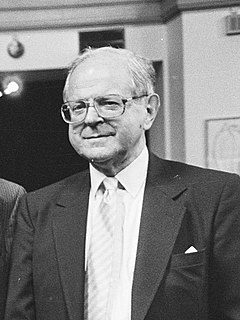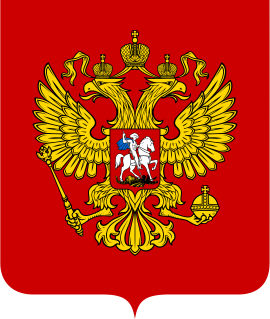
George Robert Acworth Conquest was a British historian and poet.

The Communist International (Comintern), also known as the Third International, was a Soviet-controlled international organization founded in 1919 that advocated world communism. The Comintern resolved at its Second Congress to "struggle by all available means, including armed force, for the overthrow of the international bourgeoisie and the creation of an international Soviet republic as a transition stage to the complete abolition of the state". The Comintern was preceded by the 1916 dissolution of the Second International.
Icebreaker: Who Started the Second World War? is a military history book by the Russian non-fiction author Viktor Suvorov, published in 1988. Suvorov argued that Joseph Stalin planned a conquest of Europe for many years, and was preparing to launch a surprise attack on Nazi Germany at the end of summer of 1941 to begin that plan. He says that Operation Barbarossa was a pre-emptive strike by Adolf Hitler, a claim which the Nazi leader himself had made at the time. Since the 1990s and the dissolution of the Soviet Union, this theory has received some support among historians in some post-Soviet and Central European states, but Western scholars have criticized his conclusions for lack of evidence and documentation.

German–Soviet Union relations date to the aftermath of the First World War. The Treaty of Brest-Litovsk, dictated by Germany ended hostilities between Russia and Germany; it was signed on March 3, 1918. A few months later, the German ambassador to Moscow, Wilhelm von Mirbach, was shot dead by Russian Left Socialist-Revolutionaries in an attempt to incite a new war between Russia and Germany. The entire Soviet embassy under Adolph Joffe was deported from Germany on November 6, 1918, for their active support of the German Revolution. Karl Radek also illegally supported communist subversive activities in Weimar Germany in 1919.
Soviet and Communist studies is the field of historical studies of the Soviet Union and other Communist states as well as of Communist parties such as the Communist Party USA that existed or still exist in some form in many countries, inside or outside the former Soviet Bloc. Aspects of its historiography have attracted controversy between historians on topics including totalitarianism and Cold War espionage.
Throughout the history of the Soviet Union, various forms of political repression primarily existed as a means to suppress anti-communism and anti-sovietism. While these objectives were introduced after the October Revolution, many of these efforts took forms that were continuations of practices which were employed in the Russian Empire, particularly, the use of Siberian labor camps. These practices culminated during the Stalin era, when the rise of Nazi Germany was believed to pose a direct threat to state security through its incitement of counter-revolutionary elements within Russia, fears which were partially vindicated following Germany's invasion in 1941. After Stalin's death in 1953, the "Khrushchev Thaw" saw a relaxation of these practices, followed by the increased persecution of dissidents during the Brezhnev era. Under the leadership of Mikhail Gorbachev, the policies of glasnost and perestroika virtually removed all restrictions on anti-communist speech and organizing, contributing to the collapse of the Soviet state in 1991.

The first five-year plan of the Union of Soviet Socialist Republics (USSR) was a list of economic goals, created by Communist Party General Secretary Joseph Stalin, based on his policy of socialism in one country. The plan was implemented in 1928 and took effect until 1932.

The Soviet offensive plans controversy was a debate among historians in the late 20th and early 21st centuries as to whether Joseph Stalin had planned to launch an attack against Nazi Germany in the summer of 1941. The controversy started with Viktor Suvorov with his 1980s book Icebreaker:Who started the Second World War? where he argued, based on his analysis of historical documents and data, that Stalin used Nazi Germany as a proxy to attack Europe.
Nikolay Vladimirovich Kuibyshev was a Red Army military leader and Komkor.

Estimates of the number of deaths attributable to the Soviet revolutionary and dictator Joseph Stalin vary widely. The scholarly consensus affirms that archival materials declassified in 1991 contain irrefutable data far superior to sources used prior to 1991 such as statements from emigres and other informants. A minority of authors and journalists maintain that "statistics can never fully describe what happened".

This is a select bibliography of post World War II English language books and journal articles about the Revolutionary and Civil War era of Russian (Soviet) history. The sections "General Surveys" and "Biographies" contain books; other sections contain both books and journal articles. Book entries may have references to reviews published in English language academic journals or major newspapers when these could be considered helpful. Additional bibliographies can be found in many of the book-length works listed below; see Further Reading for several book and chapter length bibliographies. The External Links section contains entries for publicly available select bibliographies from universities.
This is a select bibliography of post World War II English language books and journal articles about Stalinism and the Stalinist era of Soviet history. Book entries have references to journal reviews about them when helpful and available. Additional bibliographies can be found in many of the book-length works listed below.

This is a select bibliography of English language books and journal articles about the post-Stalinist era of Soviet history. A brief selection of English translations of primary sources is included. The sections "General Surveys" and "Biographies" contain books; other sections contain both books and journal articles. Book entries have references to journal articles and reviews about them when helpful. Additional bibliographies can be found in many of the book-length works listed below; see Further Reading for several book and chapter-length bibliographies. The External Links section contains entries for publicly available select bibliographies from universities.

The Stalin School of Falsification is a book written in 1937 by Russian revolutionary Leon Trotsky. Written after Trotsky's expulsion from the Soviet Union, the book contains a detailed account of how historians chosen by Joseph Stalin rewrote revolutionary history. A well-known example from the book concerns the revolutionary contributions by Trotsky himself about which Stalin had written glowingly in 1918, but whose special value he denied by 1924.

Everyday Stalinism or Everyday Stalinism: Ordinary Life in Extraordinary Times: Soviet Russia in the 1930s is a book by Australian academic Sheila Fitzpatrick first published in 1999 by Oxford University Press and in paperback in 2000. Sheila Fitzpatrick is the Bernadotte E. Schmitt Distinguished Service Professor (Emeritus), Department of History, University of Chicago.

Below is a list of post World War II scholarly books and journal articles written in or translated into English about communism. Items on this list should be considered a non-exhaustive list of reliable sources related to the theory and practice of communism in its different forms.

This is a select bibliography of post World War II English language books and journal articles about the Russia during the First World War, the period leading up to the war, and the immediate aftermath. For works on the Russian Revolution, please see Bibliography of the Russian Revolution and Civil War. Book entries may have references to reviews published in English language academic journals or major newspapers when these could be considered helpful.

This is a select bibliography of English language books and journal articles about the Soviet Union during the Second World War, the period leading up to the war, and the immediate aftermath. For works on the Stalinism and the Soviet Union, please see Bibliography of Stalinism and the Soviet Union. Book entries may have references to reviews published in English language academic journals or major newspapers when these could be considered helpful.

This is a select bibliography of post World War II English language books and journal articles about the History of Ukraine. Book entries have references to journal reviews about them when helpful and available. Additional bibliographies can be found in many of the book-length works listed below. See the Bibliography section for several additional book and chapter length bibliographies from academic publishers and online bibliographies from historical associations and academic institutions.
David Russell Stone is an American military historian and Professor of History and Politics at the U.S. Naval War College.











